Please, note also that in order to get better understanding on how this kind of nuclear demolition scheme worked out particularly in the WTC nuclear demolition on 9/11 (including watching the WTC demolition videos), you might need to visit this website.
Nuclear demolition
Nuclear demolition of skyscrapers was a new concept of a broader term of controlled demolition that first appeared at the end of 60s, when it became necessary to provide some satisfactory means of how to demolish modern tall steel frame buildings in order to meet necessary requirements set by a building code.
Atomic demolition
It shall be understood that this concept of nuclear demolition as a kind of controlled demolition had nothing to do with another concept - that of a so-called atomic demolition, which existed in the 50s. The difference between the two is as follows. In an atomic demolition, a building (or bridge, or tunnel, or bunker, or another structure) is being demolished by special small- or medium-caliber atomic demolition munitions (SADM or MADM) that produce a classical atmospheric nuclear blast. So a larger part of an entire explosive energy of such an atomic munitions would be spent on creation of a well-known atomic air-blast wave, a thermal radiation, a penetrating ionizing radiation, an Electromagnetic Pulse (EMP), as well as it will also cause an ensuing radioactive contamination of surroundings. So only a relatively small part of such an atomic explosion would be directed towards the main job - the demolition of the intended building, while incomparably larger part of its energy would be spent on creating unnecessary devastation around the demolished object. Judging from this point of view, an atomic demolition has never been an option when it comes to real demolition works in civil life. Real demolition works are always performed through usage of charges of conventional explosives - attached to bearing structures at right points, which allows to achieve the highest efficiency factor - meaning spending as much explosive energy as possible on the actual demolition job, and as little explosive energy as possible - on damaging surroundings. So, an atomic demolition could only be performed in times of real emergency - for example, in times of war, when to spend several weeks to calculate and prepare a "conventional" controlled demolition of an important object can not be afforded. There is yet another factor that prevents routine usage of atomic demolition munitions in demolishing any civil infrastructure, besides described above "atomic" damages that it would inevitably cause to surroundings. This is a financial factor. There is no nuclear device that could cost cheaper than 2 million US dollars, while precisely wrought SADM or MADM suppose to cost even more than that. Which makes their routine usage simply too costly.
However, the cost of nuclear device it is not an issue when it comes to demolishing of expensive tall modern skyscrapers. Apparently, it would be preferable - to spend even 10 million US dollars on a single thermo-nuclear demolition charge that would do a job in only a few seconds, than to spend a few hundreds of millions of US dollars on manual disassembling of an enormous half-kilometer tall steel structure that would take years.
Difference between atomic and nuclear demolitions
What is the difference between an old concept of an atomic demolition and that of a modern nuclear demolition? The main difference is that in an old atomic demolition a "mini-nuke" or other nuclear device produces an atmospheric nuclear explosion, while in a modern nuclear demolition some huge thermo-nuclear charge is buried deep underground and produces a typical deep underground nuclear explosion which has very different physical properties compare to an atmospheric nuclear blast.
Properties of an atmospheric nuclear explosion
About 99% of entire explosive energy of any nuclear explosion (irrespectively of an environment it occurs in) is being released in a form of [X-rays]. Actually, 100% of explosive energy of a nuclear blast is being released in a form of some rays, but ~99% of them fall within X-rays spectrum, and the remaining 1% is represented by gamma-rays, visible spectrum rays (that cause an initial white flash known as a "nuclear flash" - akin to a photo flash), as well as by neutrons, alpha-, beta-, and some other elementary particles. A summary of all these rays and elementary particles that are being instantly released by a [nuclear explosion] is called "primary radiation". So, in its initial stage any and every nuclear blast produces nothing, but a primary radiation alone, which, in turn, in 99% consists of X-rays. In atmospheric conditions X-rays can not travel very far from a nuclear blast hypocenter, because they will be stopped and absorbed by air atoms. At maximum, X-rays could only travel tens of meters around before they would be completely absorbed by surrounding air. That is why about 99% of tremendous explosive energy of an atomic blast (that could be equal to kilotons and even to megatons of TNT) would all be spent on heating surrounding air in only tens of meters around the hypocenter of the blast. This relatively small area of the surrounding air becomes overheated and begins to irradiate heat (in a form of a visible light - very similar to that irradiated by Sun, but much more intense) - this process is called a "[thermal radiation]". This extremely overheated area of the air represents a secondary effect of an atmospheric nuclear blast, traditionally called "nuclear fireballs". It shall be understood that an initial "nuclear flash" (which is of white color) that lasts only a split of a second, and a [thermal radiation] (that is of orange-yellow color and could last several seconds) are very different processes. The first one belongs to the "primary radiation" of nuclear explosion and exists in any case - irrespectively of physical environment the nuclear blast occurs, while the second one belongs to the secondary effect of an atmospheric nuclear explosion - i.e. to its "nuclear fireballs" which, in turn, could only be created in atmospheric conditions. The same thing could be said about another main destructive factor of an atomic blast - its well-known air-blast wave (some people also call it a "shock wave"). An air-blast wave is being created by the same secondary effect of an atmospheric nuclear blast - i.e. by "nuclear fireballs". Nuclear fireballs tend to expand in atmosphere, because energy is being passed over from inner "hotter" zones to outer "colder" zones which process creates air movement towards periphery. At some point expanding front of highly compressed air breaks off the nuclear fireballs' border and begins to travel on its own with a supersonic speed - smashing everything on its way. This is how the air-blast wave actually occurs.
Properties of a deep underground nuclear explosion
Considering all these obvious physical processes, it shall be understood that either of the two well-known main destructive factors of a nuclear explosion - its air-blast wave and its thermal radiation - exist only in atmospheric conditions. If a nuclear explosion occurs in deep underground conditions, it can not create any "nuclear fireballs" due to a total absence of surrounding air, and, consequently, neither an air-blast wave, nor a thermal radiation could be created. What happens during a deep underground nuclear explosion? First of all, we have to distinguish between a really deep underground nuclear explosion (i.e. in a situation when no soil above the explosion is being thrown onto the Earth surface and no crater could be so formed) and a so-called shallow sub-surface nuclear explosion which is capable to throw soil onto the surface and so to create a crater. While physical properties of a real deep underground nuclear explosion are distinctly different compare to those of a nuclear explosion in atmospheric conditions, physical properties of a shallow sub-surface nuclear blast are somehow mixed and could partly resemble either of the above two. Coming back to a real deep underground nuclear explosion. When a nuclear (or a thermo-nuclear) charge is buried deep underground and is detonated, it entire explosive energy is being released in a form of a "primary radiation" - exactly as described above. This primary radiation is being immediately absorbed by surrounding soil or rock, because neither X-rays (that constitute 99% of primary radiation volume), nor gamma-rays and other rays and particles (that constitute remaining 1%) can travel any far in underground conditions. So, while in atmospheric conditions the entire tremendous energy of an atomic (or hydrogen) blast would be spent on heating air in a radius of tens of meters around, in deep underground conditions this entire tremendous energy will be spent likewise on heating some surrounding rock. This rock will be overheated, melted, and evaporated. That is why underground nuclear explosions (providing that they occurred sufficiently deep below the Earth surface) would leave some underground cavities, sizes of which directly depend on two primary factors: 1) actual yield of a nuclear explosion; and 2) density of surrounding materials. For example, one kiloton of nuclear munitions could evaporate/melt the following quantities (in tons) of various materials:
For example, a 150 kiloton thermo-nuclear charge detonated sufficiently deep in granite rock will create a cavity of roughly 100 meters in diameter which might look like in this picture:
"Damaged" and "crashed" zones
Two distinctly different phases of creating of a cavity during a deep underground nuclear explosion could be observed, which is very important to understand in order to realize a principle of a modern nuclear demolition. Phase No.1: a cavity is created and it reaches its final "primary size". It happens when the entire energy of a nuclear explosion has been spent on heating of surrounding rock and the maximum possible quantity of rock has been already evaporated. So, a cavity of a "primary size" results exclusively from disappearance of evaporated rock. However, this cavity is not empty. It is filled with the former rock, now in gaseous form, which creates an extremely high pressure within the cavity. That is why this process proceeds further into its Phase No.2 - a cavity is being expanded by an extreme pressure of gazes inside to every direction. So it expands from its final "primary size" to its final "secondary size". It shall be understood that while "primary size" of the cavity results exclusively from disappearance of evaporated rock, it is not so when it comes to its "secondary size". Expansion of the cavity in Phase No.2 is being done at the expense of neighboring areas of rock, which are still solid. In result of this process, neighboring areas of the rock become very tightly compressed.
It could be easier understood from this diagram that explains physical processes during a typical deep underground nuclear explosion:
In result of expansion of an underground cavity from its "primary size" to its "secondary size" at least two zones of extreme disintegration of surrounding rock will be created. The next immediately after a cavity zone is called a "crashed zone". And the next outer zone is called a "damaged zone". Everything that occurs within a "crashed zone" is completely "pulverized" - i.e. reduced to a very special state of material that can not be found anywhere else in nature, but only in a "crashed zone" left by an underground nuclear explosion. That is why this state of material is absolutely unique and can not be compared with anything else. Practically it looks like this: some seemingly "intact" piece of rock might even retain its former shape and color and you could even try to take this piece of rock very carefully with your hands. But in reality this seemingly "intact" piece is extremely fragile and it could be instantly reduced into a complete microscopic dust under the slightest mechanical pressure. So if you only press this piece of rock with your bare hands it will instantly crash into dust. The same metamorphosis will occur to any and every kind of material that happens to be within such a "crashed zone" - it could be steel, stone, wood, glass, organic materials of any kind, etc. All of them will be pulverized in the abovementioned sense - i.e. they will retain their shape and color for a little while, but only to be reduced to complete microscopic dust under the slightest mechanical pressure. An approximate particle of such a "complete dust" is amazingly small. It corresponds in its size to a typical particle of a well-known radioactive dust - i.e. it does not exceed 100 microns, which is comparable with a thickness of an average human hair. It is believed that only a nuclear explosion and no other known physical process could reduce materials to such a fine dust. The next zone after the "crashed zone" is called a "damaged zone". Rock (and other materials as well) within such a "damaged zone" would be crashed too, but not to the extent of being completely "pulverized". They will be crashed to some debris ranging from millimeters- and centimeter- in size (in areas close to "crashed zone") to much larger pieces and fragments in its outer areas.
Distributions of damaged and crashed zones and principles of a modern nuclear demolition
In the above diagram all three zones - an actual cavity in the middle, a "crashed zone" and a "damaged zone" are shown as being ideally round and concentric. However, it would be true only when an underground nuclear explosion occurs "ideally" deep - let's say for a 150 kiloton yield detonated in granite rock it must be at least a half-kilometer deep or deeper. In this case resistance of surrounding rock would be equal from every direction - from up, from down, and from either side alike. That is why expansion of either "secondary cavity" and of "crashed" and "damaged" zone would be equal to every direction and forms of these zones would be relatively round. If a nuclear explosion occurs not too deep (but still deep enough as not to be considered a shallow sub-surface one), this picture will look slightly different. Because rock towards the Earth surface would offer much less resistance compare to that offered from down and from either side, the pressure of evaporated gases will try to expand the cavity towards the way of least resistance. That is why the major part of its expansion will be directed upwards. So, all of them - a cavity in the middle, a "crashed zone", and a "damaged zone" will not be ideally round. They will be rather elliptic - comparable to a form of an egg facing upwards with its sharper end, or, perhaps, their upper ends will be even "sharper" than the one of an egg. These "crashed" and "damaged" zones suppose to play a main role in an actual demolition process, thanks to their absolutely unique abilities to crash steel and concrete alike without making any distinction between them.
Practical example of a nuclear demolition scheme
Let's consider a practical nuclear demolition scheme of a skyscraper built on granite rock that has its lowest underground foundations at -27 meters (i.e. 27 meters below the Earth surface). This scheme will look like this:
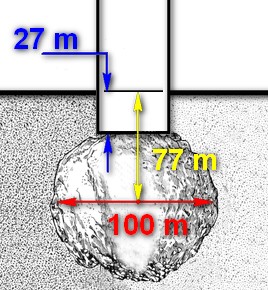
Nuclear demolition dynamics
Now let's consider demolition dynamics based on the abovementioned nuclear demolition scheme. Considering that in our case a demolition charge is not positioned "ideally deep", forms of a cavity, a "crashed" zone and a "damaged" zone produced by it will not be "ideally round" either. They will all be extended upwards, so their horizontal radiuses will be significantly decreased compare to the abovementioned "round" forms. What will happen could be easily understood from this drawing:
Once a cavity in the middle of a process will begin to expand itself from its "primary" size to its "secondary" size, it will automatically produce "crashed" (inner) and "damaged" (outer) zones that will also expand together with the expansion of the cavity. Before the lowest Tower's foundations could be reached by an upper end of the cavity, they would be reached one-by-one first by a border of the expanding "damaged zone", and then - by a border of the expanding "crashed zone". Both of them - the "damaged zone" first, and the "crashed zone" next - will continue to propagate upwards by our building structure and eventually they will reach quite far. It happens because the half-empty building structure offers much less resistance (in a sense of resistance of materials) than solid granite rock around the cavity, so, understandably, pressure wave would go by the way of least resistance - which is the way upwards. The "damaged zone" in our case which is an "outer layer" might likely reach up to 350 meters or so, while the "crashed zone" which is an "inner layer" might likely reach up to 300 meters - thus completely pulverizing at least 300 meters of our structure. This is the main goal of a modern nuclear demolition idea.
Nuclear demolition of relatively short buildings
As you can see from the above drawing, we will encounter absolutely no problem when we demolish a skyscraper, which is lower than 300 meters. Because its entire height will fit into a "crashed zone" alone. So, irrespectively of the actual building's construction and strength, it will be reduced to complete dust. But at first it will not be "pulverized" in full sense of this word. It would rather resemble a completely dried "sandy castle" that supposes to disintegrate under its own weight. Please, see a drawing below that shows how such a short building will occur in its entirety within a "crashed zone" (shown by blue). For probably a couple of seconds it will still look "normal" as if nothing happens with it. But soon it will collapse, because the most gravitational pressure will be applied to its lower parts, which will begin to crash into dust and soon the building will neatly descend onto its footprint, creating an impression that it is being demolished by some continuous process from beneath. An actual underground cavity that by that time supposes to reach the lowest underground foundations of the building is expeceted to contribute to this process - this extremely overheated cavity will consume a larger part of the descending building, melting it in the process. All what supposes to eventually remain from such a building - is a relatively small pile of debris represented by the lowest parts of the building's perimeter that might likely be saved by a pulverization process (but it might depend on the actual building's construction - these lowest parts of the perimeter might escape pulverization only in case of the underground footprint of the building is narrower than its above-ground footprint).
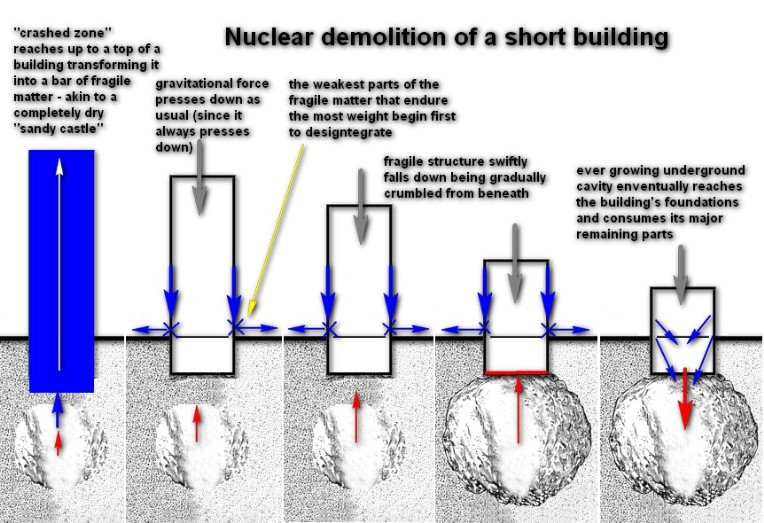
However, it will not be so easy to demolish a building if its height exceeds 300 meters. As you can see from the above drawing that shows a complete distribution of damages along a toll building, a "crashed zone" might not reach up to its top. In result we might have a heavy undamaged top of the building, with a relatively narrow "damaged zone" beneath it (which could be a source of various debris - ranging from millimeter- and centimeter-sized to relatively big fragments), and with a "crashed zone" further below - that might become a source of some fluffy dust if something would pressure its fragile structure from above. So, most likely what we will have after we set our nuclear demolition scheme in motion is that an undamaged building's top that will lose its base and crash downwards along the pulverized structure, scattering first some debris, and later - only dust until it reaches the ground. Practically it might look like is shown on this drawing:
It seems that it is possible to completely pulverize even structures higher than 300 meters but in this case we apparently need to use some nuclear charge that is more powerful than 150 kiloton in TNT yield. However, as it was mentioned above, it is not legally allowed to exceed the 150 kiloton threshold set by the "Peaceful Nuclear Explosions Treaty of 1976". That is why all current nuclear demolition schemes use thermo-nuclear charges of 150 kiloton and never more than this.
In any case, usage of such a standard thermo-nuclear demolition scheme as described above is justified even if it is used to demolish buildings higher than 300 meters, because to remove debris left by the building's insufficient pulverization would still be more expedient than to manually disassemble such a huge structure.
External readings
[1] The Containment of Soviet Underground Nuclear Explosions.
[2] The Production and Dissolution of Nuclear Explosive Melt. Glasses at Underground Test Sites in the Pacific Region. International Atomic Energy Agency.
[3] Technical details on nuclear demolition of steel-frame buildings.


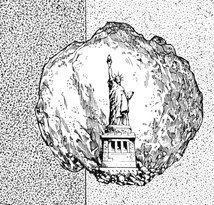
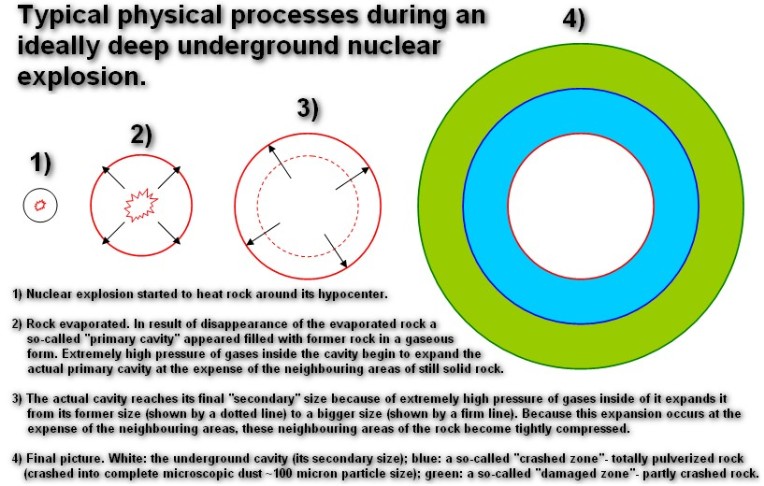
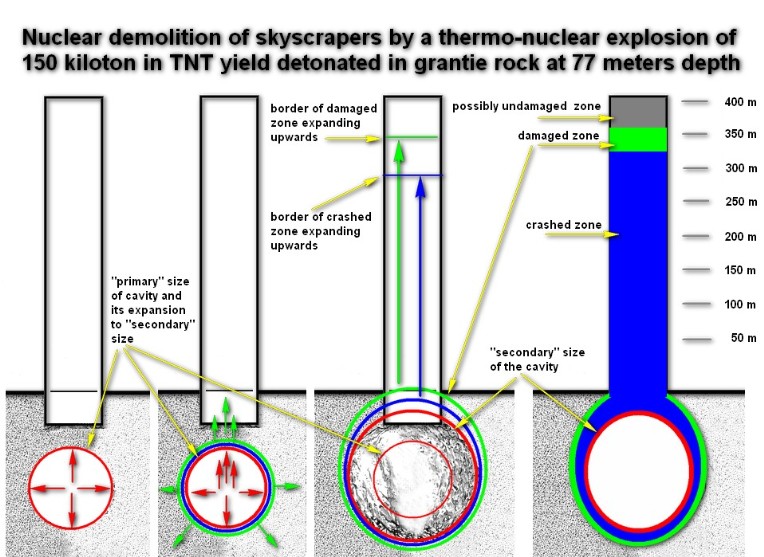
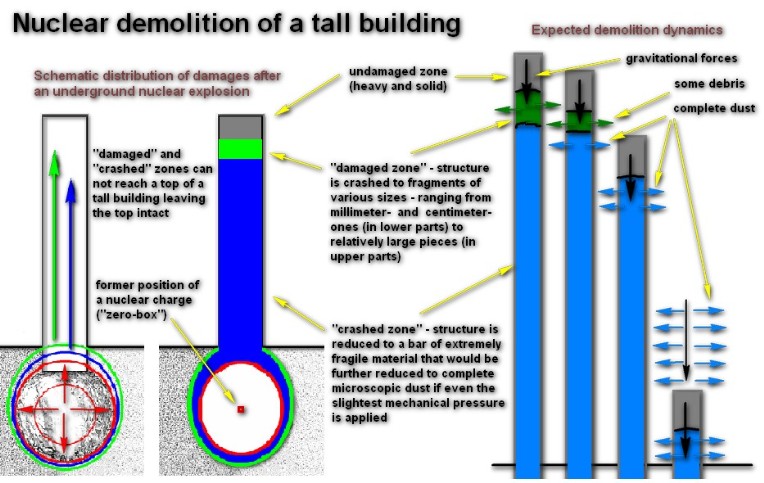



To go deep; with a Neutron BOMB.